Abstract
Prognostication is defined as “a statement about what is going to happen in the future.” In the medical arena it pertains to predicting the course and survival of a patient with certain disease processes. It is both a science and an art. Although it is recognized that no physician can ever certainly predict what the future holds, a reasonable estimation of the course ahead can certainly be ascertained and communicated to their patients. Unfortunately, prognostication, especially in advanced cancer, is fraught with many difficulties including not only omission of such discussions, but also inaccurate estimations. Using a case of a patient with metastatic lung cancer whose likelihood of survival was grossly misjudged, we outline how to approach prognostication in advanced cancer.
Keywords:Prognosis; Advanced cancer; Performance status; Metastatic lung cancer; Survival; Palliative care
Case Presentation
Mr. Z was a 69 year old caucasian male who had presented to the emergency department for community acquired pneumonia that had failed outpatient antibiotic therapy. He complained of ongoing cough, production of thick phlegm, low grade fevers and severe back and right hip pain since the last 2 weeks. He also stated during the past few months his desire to eat had decreased, he had lost 20 pounds and that he felt tired, short of breath on exertion and was spending more of his time in bed. Prior to this he was a healthy male with history of hypertension and diabetes mellitus. He was retired, had previously worked as a building contractor and served in the Vietnam War with documented exposure to Agent Orange. Although he no longer smoked, he had a history of 30 pack-years. On examination, he had rhonchi in the right lower lobe of his lung, tenderness of upper thoracic area of back and limited range of motion of his right hip. He was noted to have a white blood cell count of 17 K/mm3 (normal range 4.4- 10.7 K/mm3), albumin of 2.8 g/dL (normal range 3.4- 4.5 g/dL) and corrected calcium of 12.3 mg/dL (normal range 8.4- 9.8 mg/dL). Computed Tomography (CT) of the thorax was performed which showed a new large right upper lobe mass occluding the bronchus and extending into the mediastinum. Post-obstructive pneumonia was noted with mediastinal adenopathy. Upon further imaging the patient was found to have metastatic bone destruction of his thoracic vertebrae and right femur.
He was admitted to the acute medicine service and was given antibiotics, intravenous fluids, a bisphosphonate and opioids. Bronchoscopy was performed and the biopsy revealed invasive nonsmall cell carcinoma. The oncology service was called in to talk to the patient and family about chemotherapeutic options. During the meeting treatment with carboplatin and paclitaxel was presented, along with the possibility of radiation and immunotherapy with the novel agent nivolumab should he progress on standard treatment, based on which he was offered a prognosis of up to three years.
The palliative care team was called for the discussion of advance directives. They reviewed the case and collaborated with the medicine and oncology service, inviting the services to their meeting with the patient as they disagreed with the survival time that had been communicated. The patient was receptive to talking about his disease, having prognosis conveyed and discussing goals of care. Based on priordiscussions with healthcare providers, the patient and family had optimistic expectations. Given his advanced metastatic non-small cell lung cancer with bone involvement, deteriorating functional status, dyspnea, post-obstructive pneumonia, hypoalbuminemia and hypercalcemia, the patient and family were told by the palliative care team that his life expectancy was likely in the realm of weeks to three months and after exploring his goals, recommended hospice care. The patient had difficulty accepting this and expressed the desire for aggressive chemotherapy with no limitations of care.
Over the next few days he became hypoxic, increasingly short of breath, delirious and repeat CT revealed bilateral pulmonary embolisms. He was started on anticoagulation and haloperidol. His hypercalcemia did not respond to treatment. The palliative care team now revisited prognosis with the patient and his family. Although he was no longer cognitively intact, the family was told that his passing away seemed more imminent, as in days to weeks. They were saddened but appreciated the honest disclosure. The patient’s respiratory status improved but his delirium did not reverse and he went on to receive “palliative” chemotherapy per oncology who offered this to honor the patient’s wishes. The subsequent day he deteriorated further and imaging showed his right lung had collapsed due to tumor progression. Another family meeting was held at which point in time the family decided they wanted the patient to be comfortable and not undergo intubation or pursue other treatments. He was brought to the palliative care inpatient unit where he was given oxygen, opioids around the clock for pain and relief of dyspnea, with breakthrough medication and treatment for his delirium. He passed away peacefully in two days and the family went on to raise funds for supporting palliative care at the hospital.
The patient’s actual survival from time of diagnosis of cancer to death was twenty-seven days. The clinician calculation of his inaccurate prognosis in the realm of three years led to his decision for harmful treatments near the end of life, created mistrust of the palliative care team and generated emotional and psychological turmoil for the patient and the family due to drastically conflicting estimations of survival.
Introduction
Prognostication is one of the core skills in medicine [1]. When healthcare providers estimate survival, they must face some of the most serious, emotional and meaningful aspects of their careers [2]. Unfortunately, there is often an emphasis on diagnosis, staging and therapeutics in cancer rather than predicting and conveying prognosis [3]. As medicine leads physicians further away from attaining this skill, they lack the necessary confidence of ascertaining the disease course and likelihood of survival. As an example, amongst a cohort of 697 internists; 89% believed they should avoid being too specific, 80% believed patients expected too much certainty, 60% found making a prognosis stressful and 58% termed it difficult, 56% felt they had inadequate training in prognostication, 50% believed if they were to make an error, patients would lose confidence in them and 43% preferred to wait to be asked by a patient before offering predictions [4]. A systematic review was conducted of 46 studies relating to discussing prognosis with patients with progressive, advanced life-limiting illnesses. Results showed that although the majority of physicians believed that patients and caregivers should be told the truth about the prognosis, in practice, many withheld these discussions. Reasons included perceived lack of training, stress, limited time, fear of a negative impact on the patient, uncertainty about prognostication, requests from caregivers to withhold information and a feeling of hopelessness regarding the unavailability of further curative treatment [5].
On the other hand, majority of patients and families want information regarding the illness, possible future symptoms and their management, and expected survival [6, 7], especially when dealing with cancer [8]. Patients report that they want to have time to express their wishes, to appoint healthcare proxies, to put their financial affairs in order and to make their funeral preparations [9]. Contrary to physician worries [10], prognostic information itself has not been found to contribute towards depression in patients with advanced cancer [11]. Also, when relaying prognostic information, patients with incurable cancer characterized doctor’s behaviors such as appearing to be nervous or uncomfortable, or using euphemisms, as not facilitating hope [12].
Communication of prognosis is essential because it may help facilitate discussion of advance directives which in itself allows patients to avoid potentially harmful and inappropriate cancer therapies towards the end of life [13-15]. Accurate prognostication also results in a higher likelihood of the focus towards aggressive symptom management [16] emphasis on better quality of life and expedited referrals to hospice services [17].
Unfortunately even when physicians do convey prognosis, they are likely to be grossly inaccurate [18] and overoptimistic [19]. Physician approximation of survival is commonly overestimated by a factor of three to five [20]. The recognition of this phenomenon and the progress of palliative medicine have served to startshifting focus towards better training in prognostication.
Formulating a prognosis in advanced cancer
Primarily, it should be recognized that estimation of life expectancy in advanced cancer patients is feasible and facilitated by a number of tools the physician has at their disposal, such as the presence of certain signs and symptoms, laboratory examinations, and prognostic scores [21,22]. While cancer patients are commonly staged by the size of their tumor, how sick they are from the tumor and other medical conditions should not be ignored [23].
Understanding the disease trajectory of cancer: Patients with cancer experience a sharp decline in functional status [24] and quality of life [25] in the last months of life, which can occasionally be blunted by treatment (Figure 1), whereas other diseases tend to have a more gradual decline. Recognizing illness trajectories improves our understanding of the patient and families’ needs [26]. Identifying where the patient lies in the course of disease is important because at earlier stages prognostication is typically based on tumor stage [3,27], whereas this is not the case in advanced disease.
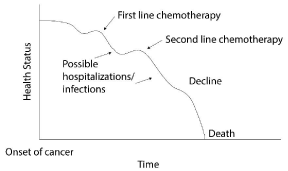
Figure 1: Cancer disease trajectory.
Clinical estimation of survival (CES): As outlined before, CES has inherent shortcomings. It has been shown that more experienced physicians [20,28,29] and those in hospice or palliative medicine fields [30] have higher prognostic accuracy. Also, the longer the duration of doctor-patient relationship, the lower the prognostic accuracy [20].
However, CES is still considered one of the main criteria driving patient therapeutics [31]. In a review published in 2000, CES was reported as having an independent effect on patient survival when used with other prognostic tools [27].
Physicians are more likely to be able to predict prognosis in cancer patients who would survive for three months, and those who would not, as compared to discrimination between patients who would survive for one year and those who would not [32]. Therefore revision of CES over the course of disease is advisable.
Performance status: Performance Status (PS) is a global measure of a patient’s functional capacity. There are a number of scales currently used to help physicians assess PS such as the Karnofsky Performance Status (KPS), the Eastern Cooperative Oncology Group (ECOG) PS and the Palliative Performance Scale (PPS).
The KPS is the most widely used tool for quantifying the functional status of cancer patients [33,34] (Figure 2). It accounts for statistically significant prediction in survival of patients with advanced cancer [35-40] with higher specificity for lower KPS levels. Each increase in one KPS level, e.g., 20 to 30, yields an increase of approximately 15 days of survival in patients with terminal cancer [37]. KPS less than 50 is generally associated with worse prognosis [18], with KPS 30-40 correlating with median 7 week life expectancy and KPS 10-20 with median 2 week life expectancy in cancer patients [37].
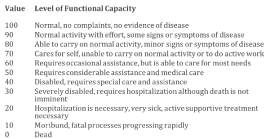
Figure 2: Karnofsky Performance Status.
The ECOG performance status is predictive of survival in both advanced and terminal cancer [41-45] (Figure 3) and has less interobserver variability [46]. It is also routinely used in the selection of patients for chemotherapy and early phase clinical trials [47,48].
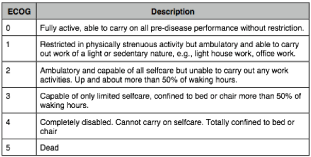
Figure 3: ECOG Performance Status.
The PPS is a derivative of KPS (Figure 4), with criteria including disease extent, ambulation, activity, self-care, intake and level of consciousness. The PPS score has been shown to have prognostic value, with PPS 10-20 correlating with median survival of 6 days, PPS 30-50 with median survival of 41 days and PPS 60-70 with median survival of 108 days [49,50].
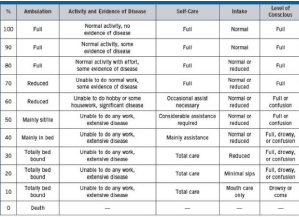
Figure 4: Palliative Performance Scale.
Symptoms: National Hospice study data revealed fivecardinal symptoms that predicted survival: Dyspnea, anorexia, weight loss, xerostomia and dysphagia [37]. Asthenia, confusion, drowsiness and delirium have also been shown to have prognostic value in terminal cancer [51]. In patients with advanced cancer, the presence of dyspnea portends a survival of less than 30 days [40], anorexia less than 58 days [40,51], xerostomia less than 50 days [52], dysphagia less than 30 days [40] and confusion less than 38 days [51,52]. In general, the greater the number of symptoms present, the worse the prognosis [52,53].
Biologic parameters: A number of biomarkers are often looked at for prognosis and in combination with other factors can be helpful. These have been extensively described in the literature. Low serum sodium in cancer patients with values less than 137 mEq/L have an increased risk of death [54]. Low albumin is indicative of poor survival, independent of other factors [55]. High total WBC and low lymphocyte percentage are related to poor prognosis [18,56,57].
Thrombocytosis is another negative prognostic indicator studied in multiple cancers such as gastric [58], esophageal [59], cervical [60,61], ovarian [62], renal [63,64] and lung [65,66]. Other biomarkers of prognostic value in cancer patients include elevated serum bilirubin [67], elevated alkaline phosphatase [68,69] and elevated lactate dehydrogenase levels [18,55]. Increased levels of C-reactive protein independently [70] and associated with vitamin B12 greater than 600 pmol/L in cancer patients is associated with higher mortality [71]. It has also been shown that uric acid levels greater than 7.2mg/ dL correlated to mortality in cancer patients [72].
In patients with malignant hypercalcemia, life expectancy is poor as approximately 50 percent of such patients die within 30 days [73], though there is evidence to suggest treatment improves survival [74]. Nevertheless, recurrent hypercalcemia can bedifficult to control [75]. Hypercalcemia leads to progressive mental impairment and renal failure, which are common terminal events in patients with cancer [76].
Prognostic scores: Using a combination of the factors described above, a number of prognostic scores have been developed that permit a rapid estimate of life expectancy by placing patients into broad groups that differ significantly in survival [21]. Two widely used scores are the Palliative Prognostic Index (PPI) and the Palliative Prognostic Score (PaP).
The PaP (Figure 5) incorporates KPS, CES, anorexia, dyspnea and biomarkers and has been extensively validated [56,77-79]. Numerical scores are given to each variable which are summed up. The total score then stratifies patients into 3 groups which correspond to 30 day survival [56]. As it includes biomarkers, calculation of PaP requires blood draws. One main criticism of the PaP is the inclusion of the subjective nature of the CES and substitute prognostic models have been developed using only clinical and laboratory values [80]. Furthermore, delirium is not incorporated into the PaP which was later shown to sub divide each population categorized by the PaP Score into two further prognostic subgroups [81].
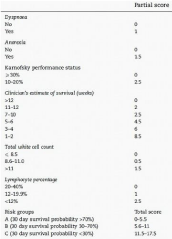
Figure 5: Palliative Prognostic Score.
The PPI (Figure 6) focuses on functional status and symptoms and has been shown to significantly improve CES when dealing with cancer patients [82]. It includes PPS, oral intake, dyspnea, edema and delirium. Based on the score assigned, patients are allocated into one of three groups, indicating survival times less than 6 weeks, 3-6 weeks or greater than 6 weeks. The PPI is quick and easy to use, and can be applied to patients with cancer, whether in the hospital or at home [83].
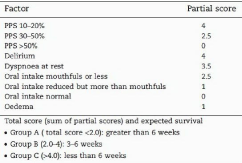
Figure 6: Palliative Prognostic Index.
Other clinical signs: Adjusting for age, race, and stage, diagnosis of venous thromboembolism during the first year following cancer diagnosis has been found to be a significant predictor of decreased survival [84,85]. Infections such as pneumonia carry an increased risk of death [86] and may also preclude patients from chemotherapy. While there is a lack of evidence cited in the literature, as an anecdotal observation, patients with advanced lung cancer who develop recurrent post-obstructive pneumonias despite radiation or chemotherapy usually have a short term prognosis and die within a few months.
Prognostication pearls
Prognosis should usually be conveyed in ranges, such as hours to days, days to weeks or weeks to months. Distinction of survival less than 6 months is important to determine eligibility for hospice services. All clinicians must recognize that prognosis is not static and any acute change can alter prognosis significantly. Therefore physicians must be ready to readdress and revise prognosis with patients and family members as often as needed.
Palliative care and focus on prognostication
Involvement of palliative medicine can provide input to the primary service and help in prognostication of patients [87]. Patients with stage III to IV cancer with comorbidities, symptoms or poor functional status should be considered for a palliative care consult.
Conclusion
Despite its challenges, there are a number of tools available to help physicians prognosticate patients with advanced cancer. Multiple factors need to be considered when anticipating survival and it is insufficient to rely on tumor stage only. Physicians must ensure they are not missing the big picture, as in the case of our patient who not only had advanced lung cancer but was also suffering from dyspnea, anorexia, hypoalbuminemia, hypercalcemia and pneumonia with deteriorating functional status, then went on to develop bilateral pulmonary embolisms and delirium. He was still being told he may have a prognosis of up to years due to novel chemotherapeutic drugs available even if standard chemotherapy failed. Our patient received one dose of first-line chemotherapy and did not live long enough to receive a second dose or second-line chemotherapy.
Increased accuracy of prognosis helps patients and surrogates make advance directive decisions, allows for preparations, shifts focus towards symptom management and helps avoid burdensome or possibly harmful treatments as patients become sicker. Often a palliative care consult can be initiated early in the disease trajectory to facilitate with prognostication and outlining goals of care.
References
- Hipócrates, Hippocrates; with an English Translation WHS Jones. 1979: William Heinemann.
- Christakis NA. Death foretold: prophecy and prognosis in medical care. 2001: University of Chicago Press.
- Lamont EB, Christakis NA. Complexities in prognostication in advanced cancer: "to help them live their lives the way they want to". JAMA. 2003; 290: 98-104.
- Christakis NA, Iwashyna TJ. Attitude and self-reported practice regarding prognostication in a national sample of internists. Arch Intern Med. 1998; 158: 2389-2395.
- Hancock K, Clayton JM, Parker SM, Wal der S, Butow PN, Carrick S, et al. Truth-telling in discussing prognosis in advanced life-limiting illnesses: a systematic review. Palliat Med. 2007; 21: 507-517.
- Evans LR, Boyd EA, Malvar G, Apatira L, Luce JM, Lo B, et al. Surrogate decision-makers' perspectives on discussing prognosis in the face of uncertainty. Am J Respir Crit Care Med. 2009; 179: 48-53.
- Parker SM, et al. A systematic review of prognostic/end-of-life communication with adults in the advanced stages of a life-limiting illness: patient/caregiver preferences for the content, style, and timing of
- Kirk P, Kirk I, Kristjanson LJ. What do patients receiving palliative care for cancer and their families want to be told? A Canadian and Australian qualitative study. BMJ. 2004; 328: 1343.
- Stone PC, Lund S. Predicting prognosis in patients with advanced cancer. Ann Oncol. 2007; 18: 971-976.
- Mack JW1, Smith TJ . Reasons why physicians do not have discussions about poor prognosis, why it matters, and what can be improved. J Clin Oncol. 2012; 30: 2715-2717.
- Barnett MM. Does it hurt to know the worst?--psychological morbidity, information preferences and understanding of prognosis in patients with advanced cancer. Psychooncology. 2006; 15: 44-55.
- Hagerty RG, Butow PN, Ellis PM, Lobb EA, Pendlebury SC, Leighl N, et al. Communicating with realism and hope: incurable cancer patients' views on the disclosure of prognosis. J Clin Oncol. 2005; 23: 1278-1288.
- Earle CC, Neville BA, Landrum MB, Ayanian JZ, Block SD, Weeks JC. Trends in the aggressiveness of cancer care near the end of life. J Clin Oncol. 2004; 22: 315-321.
- Matsuyama R, S Reddy, and TJ Smith. Why Do Patients Choose Chemotherapy Near the End of Life? A Review of the Perspective of Those Facing Death From Cancer. Journal of Clinical Oncology. 2006; 24: 3490-3496.
- Weeks JC, Cook EF, O'Day SJ, Peterson LM, Wenger N, Reding D, et al. Relationship between cancer patients' predictions of prognosis and their treatment preferences. JAMA. 1998; 279: 1709-1714.
- Parkes CM. Commentary: prognoses should be based on proved indices not intuition. BMJ. 2000; 320: 473.
- Christakis NA. Predicting patient survival before and after hospice enrollment. Hosp J. 1998; 13: 71-87.
- Gripp S, et al. Survival prediction in terminally ill cancer patients by clinical estimates, laboratory tests, and self-rated anxiety and depression. Journal of Clinical Oncology. 2007; 25: 3313-3320.
- Glare P, Virik K, Jones M, Hudson M, Eychmuller S, Simes J, et al. A systematic review of physicians' survival predictions in terminally ill cancer patients. BMJ. 2003; 327: 195-198.
- Christakis NA, et al. Extent and determinants of error in doctors' prognoses in terminally ill patients: prospective cohort study Commentary: Why do doctors overestimate? Commentary: Prognoses should be based on proved indices not intuition. Bmj. 2000; 320: 469-473.
- Maltoni M, et al. Prognostic Factors in Advanced Cancer Patients: Evidence-Based Clinical Recommendations—A Study by the Steering Committee of the European Association for Palliative Care. Journal of Clinical Oncology. 2005; 23: 6240-6248.
- Chow E, et al. How accurate are physicians' clinical predictions of survival and the available prognostic tools in estimating survival times in terminally III cancer patients? A systematic review. Clinical Oncology. 2001; 13: 209-218.
- Piccirillo JF, Tierney RM, Costas I, Grove L, Spitznagel EL Jr. Prognostic importance of comorbidity in a hospital-based cancer registry. JAMA. 2004; 291: 2441-2447.
- Teno JM, Weitzen S, Fennell ML, Mor V. Dying trajectory in the last year of life: does cancer trajectory fit other diseases? J Palliat Med. 2001; 4: 457-464.
- Morris JN, Sherwood S. Quality of life of cancer patients at different stages in the disease trajectory. J Chronic Dis. 1987; 40: 545-556.
- Murray SA, et al. Illness trajectories and palliative care. International Perspectives on Public Health and Palliative Care. 2013; 30.
- Viganò A, Dorgan M, Buckingham J, Bruera E, Suarez-Almazor ME. Survival prediction in terminal cancer patients: a systematic review of the medical literature. Palliat Med. 2000; 14: 363-374.
- McClish DK, Powell SH. How well can physicians estimate mortality in a medical intensive care unit? Med Decis Making. 1989; 9: 125-132.
- Winkler RL and RM Poses. Evaluating and combining physicians' probabilities of survival in an intensive care unit. Management science. 1993; 39: 1526-1543.
- Temel JS, et al. Longitudinal perceptions of prognosis and goals of therapy in patients with metastatic non–small-cell lung cancer: Results of a randomized study of early palliative care. Journal of Clinical Oncology. 2011; 29: 2319-2326.
- Viganò A, Dorgan M, Bruera E, Suarez-Almazor ME. The relative accuracy of the clinical estimation of the duration of life for patients with end of life cancer. Cancer. 1999; 86: 170-176.
- Mackillop WJ, Quirt CF. Measuring the accuracy of prognostic judgments in oncology. J Clin Epidemiol. 1997; 50: 21-29.
- Karnofsky DA. The clinical evaluation of chemotherapeutic agents in cancer. Evaluation of chemotherapeutic agents, 1949.
- Karnofsky DA, et al. The use of the nitrogen mustards in the palliative treatment of carcinoma. With particular reference to bronchogenic carcinoma. Cancer. 1948; 1: 634-656.
- Yates JW, Chalmer B, McKegney FP. Evaluation of patients with advanced cancer using the Karnofsky performance status. Cancer. 1980; 45: 2220-2224.
- Mor V, Laliberte L, Morris JN, Wiemann M. The Karnofsky Performance Status Scale. An examination of its reliability and validity in a research setting. Cancer. 1984; 53: 2002-2007.
- Reuben DB, Mor V, Hiris J. Clinical symptoms and length of survival in patients with terminal cancer. Arch Intern Med. 1988; 148: 1586-1591.
- 38. Grabowski CM, JA Unger, and RA Potish. Factors predictive of completion of treatment and survival after palliative radiation therapy. Radiology. 1992; 184: 329-332.
- Maltoni M, et al. Clinical prediction of survival is more accurate than the Karnofsky performance status in estimating life span of terminally ill cancer patients. European Journal of Cancer. 1994; 30: 764-766.
- Maltoni M, Pirovano M, Scarpi E, Marinari M, Indelli M, Arnoldi E, et al. Prediction of survival of patients terminally ill with cancer. Results of an Italian prospective multicentric study. Cancer. 1995; 75: 2613-2622.
- Allard P, Dionne A, Potvin D. Factors associated with length of survival among 1081 terminally ill cancer patients. J Palliat Care. 1995; 11: 20-24.
- Elson PJ, Witte RS, Trump DL. Prognostic factors for survival in patients with recurrent or metastatic renal cell carcinoma. Cancer Res. 1988; 48: 7310-7313.
- Buccheri G, D Ferrigno, and M Tamburini. Karnofsky and ECOG performance status scoring in lung cancer: a prospective, longitudinal study of 536 patients from a single institution. European Journal of Cancer. 1996; 32: 1135-1141.
- Kalser MH, Barkin J, MacIntyre JM. Pancreatic cancer. Assessment of prognosis by clinical presentation. Cancer. 1985; 56: 397-402.
- Lee J, Lim T, Uhm JE, Park KW, Park SH, Lee SC, et al. Prognostic model to predict survival following first-line chemotherapy in patients with metastatic gastric adenocarcinoma. Ann Oncol. 2007; 18: 886-891.
- Sørensen JB, Klee M, Palshof T, Hansen HH. Performance status assessment in cancer patients. An inter-observer variability study. Br J Cancer. 1993; 67: 773-775.
- Bachelot T, Ray-Coquard I, Catimel G, Ardiet C, Guastalla JP, Dumortier A, et al. Multivariable analysis of prognostic factors for toxicity and survival for patients enrolled in phase I clinical trials. Ann Oncol. 2000; 11: 151-156.
- Rogatko A, Babb JS, Wang H, Slifker MJ, Hudes GR. Patient characteristics compete with dose as predictors of acute treatment toxicity in early phase clinical trials. Clin Cancer Res. 2004; 10: 4645-4651.
- Anderson F, Downing GM, Hill J, Casorso L, Lerch N. Palliative performance scale (PPS): a new tool. J Palliat Care. 1996; 12: 5-11.
- Morita T, Tsunoda J, Inoue S, Chihara S. The Palliative Prognostic Index: a scoring system for survival prediction of terminally ill cancer patients. Support Care Cancer. 1999; 7: 128-133.
- Llobera J, Esteva M, Rifà J, Benito E, Terrasa J, Rojas C, et al. Terminal cancer. duration and prediction of survival time. Eur J Cancer. 2000; 36: 2036-2043.
- Tamburini M, Brunelli C, Rosso S, Ventafridda V. Prognostic value of quality of life scores in terminal cancer patients. J Pain Symptom Manage. 1996; 11: 32-41.
- Teunissen SC, de Graeff A, de Haes HC, Voest EE. Prognostic significance of symptoms of hospitalised advanced cancer patients. Eur J Cancer. 2006; 42: 2510-2516.
- Sajadieh A, Binici Z, Mouridsen MR, Nielsen OW, Hansen JF, Haugaard SB. Mild hyponatremia carries a poor prognosis in community subjects. Am J Med. 2009; 122: 679-686.
- Kikuchi N, Ohmori K, Kuriyama S, Shimada A, Nakaho T, Yamamuro M, et al. Survival prediction of patients with advanced cancer: the predictive accuracy of the model based on biological markers. J Pain Symptom Manage. 2007; 34: 600-606.
- Pirovano M, Maltoni M, Nanni O, Marinari M, Indelli M, Zaninetta G, et al. A new palliative prognostic score: a first step for the staging of terminally ill cancer patients. Italian Multicenter and Study Group on Palliative Care. J Pain Symptom Manage. 1999; 17: 231-239.
- Maltoni M, Pirovano M, Nanni O, Marinari M, Indelli M, Gramazio A, et al. Biological indices predictive of survival in 519 Italian terminally ill cancer patients. Italian Multicenter Study Group on Palliative Care. J Pain Symptom Manage. 1997; 13: 1-9.
- Ikeda M, Furukawa H, Imamura H, Shimizu J, Ishida H, Masutani S, et al. Poor prognosis associated with thrombocytosis in patients with gastric cancer. Ann Surg Oncol. 2002; 9: 287-291.
- Shimada H, Oohira G, Okazumi S, Matsubara H, Nabeya Y, Hayashi H, et al. Thrombocytosis associated with poor prognosis in patients with esophageal carcinoma. J Am Coll Surg. 2004; 198: 737-741.
- Hernandez E, Lavine M, Dunton CJ, Gracely E, Parker J. Poor prognosis associated with thrombocytosis in patients with cervical cancer. Cancer. 1992; 69: 2975-2977.
- Lopes A, Daras V, Cross PA, Robertson G, Beynon G, Monaghan JM. Thrombocytosis as a prognostic factor in women with cervical cancer. Cancer. 1994; 74: 90-92.
- Zeimet AG, Marth C, Müller-Holzner E, Daxenbichler G, Dapunt O. Significance of thrombocytosis in patients with epithelial ovarian cancer. Am J Obstet Gynecol. 1994; 170: 549-554.
- Symbas NP, Townsend MF, El-Galley R, Keane TE, Graham SD, Petros JA. Poor prognosis associated with thrombocytosis in patients with renal cell carcinoma. BJU Int. 2000; 86: 203-207.
- Bensalah K, Leray E, Fergelot P, Rioux-Leclercq N, Tostain J, Guillé F, et al. Prognostic value of thrombocytosis in renal cell carcinoma. J Urol. 2006; 175: 859-863.
- Pedersen LM, Milman N. Prognostic significance of thrombocytosis in patients with primary lung cancer. Eur Respir J. 1996; 9: 1826-1830.
- Aoe K, Hiraki A, Ueoka H, Kiura K, Tabata M, Tanaka M, et al. Thrombocytosis as a useful prognostic indicator in patients with lung cancer. Respiration. 2004; 71: 170-173.
- Rosenthal MA, Gebski VJ, Kefford RF, Stuart-Harris RC. Prediction of life-expectancy in hospice patients: identification of novel prognostic factors. Palliat Med. 1993; 7: 199-204.
- Chau I, Norman AR, Cunningham D, Waters JS, Oates J, Ross PJ. Multivariate prognostic factor analysis in locally advanced and metastatic esophago-gastric cancer--pooled analysis from three multicenter, randomized, controlled trials using individual patient data. J Clin Oncol. 2004; 22: 2395-2403.
- Halabi S, Small EJ, Kantoff PW, Kattan MW, Kaplan EB, Dawson NA, et al. Prognostic model for predicting survival in men with hormone-refractory metastatic prostate cancer. J Clin Oncol. 2003; 21: 1232-1237.
- McMillan DC, Elahi MM, Sattar N, Angerson WJ, Johnstone J, McArdle CS. Measurement of the systemic inflammatory response predicts cancer-specific and non-cancer survival in patients with cancer. Nutr Cancer. 2001; 41: 64-69.
- Geissbühler P, B Mermillod and CH Rapin. Elevated serum vitamin B12 levels associated with CRP as a predictive factor of mortality in palliative care cancer patients: a prospective study over five years. Journal
- Shin HS, Lee HR, Lee DC, Shim JY, Cho KH, Suh SY. Uric acid as a prognostic factor for survival time: a prospective cohort study of terminally ill cancer patients. J Pain Symptom Manage. 2006; 31: 493-501.
- Ralston SH, et al. Cancer-associated hypercalcemia: morbidity and mortality: clinical experience in 126 treated patients. Annals of internal medicine. 1990; 112: 499-504.
- Blomqvist CP. Malignant hypercalcemia--a hospital survey. Acta Med Scand. 1986; 220: 455-463.
- Body JJ. Hypercalcemia of malignancy. Semin Nephrol. 2004; 24: 48-54.
- Stewart AF. Clinical practice. Hypercalcemia associated with cancer. N Engl J Med. 2005; 352: 373-379.
- Glare P, Sinclair C, Downing M, Stone P, Maltoni M, Vigano A. Predicting survival in patients with advanced disease. Eur J Cancer. 2008; 44: 1146-1156.
- Glare P and K Virik. Independent prospective validation of the PaP score in terminally ill patients referred to a hospital-based palliative medicine consultation service. Journal of pain and symptom management. 2001; 22: 891-898.
- Maltoni M, Nanni O, Pirovano M, Scarpi E, Indelli M, Martini C, et al. Successful validation of the palliative prognostic score in terminally ill cancer patients. Italian Multicenter Study Group on Palliative Care. J Pain Symptom Manage. 1999; 17: 240-247.
- Gwilliam B, Keeley V, Todd C, Gittins M, Roberts C, Kelly L, et al. Development of prognosis in palliative care study (PiPS) predictor models to improve prognostication in advanced cancer: prospective cohort study. BMJ. 2011; 343: d4920.
- Caraceni A, Nanni O, Maltoni M, Piva L, Indelli M, Arnoldi E, et al. Impact of delirium on the short term prognosis of advanced cancer patients. Italian Multicenter Study Group on Palliative Care. Cancer. 2000; 89: 1145-1149.
- Morita T, et al. Improved accuracy of physicians' survival prediction for terminally ill cancer patients using the Palliative Prognostic Index. Palliative medicine. 2001; 15: 419-424.
- Stone CA, Tiernan E, Dooley BA. Prospective validation of the palliative prognostic index in patients with cancer. J Pain Symptom Manage. 2008; 35: 617-622.
- Chew HK, Wun T, Harvey D, Zhou H, White RH. Incidence of venous thromboembolism and its effect on survival among patients with common cancers. Arch Intern Med. 2006; 166: 458-464.
- Sørensen HT, Mellemkjaer L, Olsen JH, Baron JA. Prognosis of cancers associated with venous thromboembolism. N Engl J Med. 2000; 343: 1846-1850.
- Gail MH, Eagan RT, Feld R, Ginsberg R, Goodell B, Hill L, et al. Prognostic factors in patients with resected stage I non-small cell lung cancer. A report from the Lung Cancer Study Group. Cancer. 1984; 54: 1802-1813.
- Glare PA, Sinclair CT. Palliative medicine review: prognostication. J Palliat Med. 2008; 11: 84-103.
